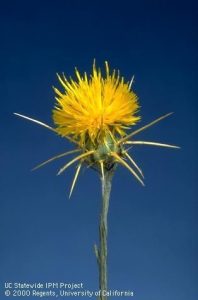Weeds, weeds, weeds! Have you noticed? This has been a banner year for weeds. Our cool late spring and repeated late rains created multiple germination periods; weed seeds in the soil had many opportunities to sprout. And sprout they did!
Now, weeds have set seed and are drying along roadsides, in our fields and landscapes. All those weed seeds will require diligent effort next spring! It’s time to plan your weed attack to prevent next year’s seedlings.
What can be done? First of all, identify your weeds. Different weeds require different treatments. Is it an annual or perennial? Does it propagate by wind-blown seeds or by runners? The University of California Integrated Pest Management website, www.ipm.ucdavis.edu, has weed-identification guides that are fun and easy to use. The website also offers treatment guidelines.
Remove weeds by hand, if possible. Since most weeds have set seed now, double bag plants in black plastic garbage bags to prevent spreading more seeds. Let them sit in the sun for the next several weeks to kill the plant, and burn them when you can obtain a burn permit.
Mow or use a line trimmer to cut weeds standing in large areas. Mow only early in the morning to prevent sparks igniting dry vegetation. Rake weeds into large piles to burn after the rainy season begins. (Seedlings will need to be treated in the spring when they emerge.)
In small landscape areas that have been cleared, apply three to four inches of mulch to deprive any weed seeds of sunlight. Larger areas-such as pastures-may need an application of a broad-leaf herbicide with pre-emergent characteristics.
Herbicides most often recommended are clopyralid (one brand name is Transline) and aminopyralid (Milestone). These require a permit from the county agriculture department. Note: these herbicides are NOT approved for use on lawns.
In the California foothills, yellow starthistle (YST) is perhaps the most common weed of concern. More and more the individual homeowner is becoming the key to containing and eliminating this invasive plant. Yellow starthistle can be hand-pulled at any time in its lifespan. In its present spiny stage, it can inflict pain, so be sure to wear gloves. Double-bag the plants and burn them later in the fall.
A new herbicide on the market, Star Thistle Killer, is available at several local home centers and nurseries and can be purchased without a permit. One spray application on small parcels of less than two acres during the late fall, winter, or early spring will be effective in preventing yellow starthistle seedling germination next spring.
Local pest control companies are also available to provide a one-time herbicide application for yellow starthistle. For more information, please call the Yellow Starthistle Leading Edge Project in the UC Cooperative Extension office at (209) 533-6993.
Information adapted from the University of California Integrated Pest Management Program and from “Yellow Starthistle: Brief Homeowner Information Sheet” by John E. Otto, Amador County Master Gardener.



